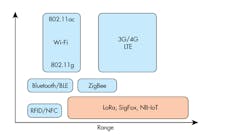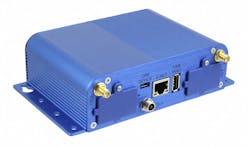Download this article as a .PDF
Wireless sensors are often synonymous with Internet of Things (IoT) devices. These can include high-speed solutions like Wi-Fi or mesh technologies like ZigBee. Unfortunately, when it comes to wireless technology, designers normally need to pick two out of three characteristics: low power, long distance, or high speed (Fig. 1). Low power in this case would be a device that can operate continuously for more than 10 years and over a distance on the order of kilometers. Low cost is also a desirable characteristic.
There are a number of ways to address low-power, long-range IoT, but the three main competitors at this point are Sigfox, LoRaWAN Alliance LoRaWAN, and 3rd Generation Partnership Project (3GPP) NB-IoT (narrow band IoT). Each has a different set of attributes that designers may prefer, but usually a solution will utilize one or the other.
There are modular platforms like the Multi-Tech Systems Conduit gateway (Fig. 2) supporting a pair of mCards that can handle protocols like LoRaWAN and LTE. It also has a Power-over-Ethernet (PoE) wired network connection. Most of these low-power networks are rooted to a TCP/IP backbone like the Internet.
Sigfox
Sigfox is a proprietary system supported by number of equipment vendors that uses technology licensed by Sigfox. The system is essentially a single global network, but coverage will be needed where devices are deployed. Pricing for services depends upon a number of variables such as the number of messages per day and number of devices.
There is mandatory certification so all devices are designed to work together. The devices utilize 200 KHz of public spectrum and operate with a throughput of 100 to 600 Kbits/s depending upon distance and other factors.
Sigfox uses binary phase-shift keying (BPSK). It has an asymmetric architecture that uses sensitive base stations for faster upload speeds, but more limited download capability. As with most long-distance, low-power solutions, it has a small, 12-byte packet payload that is sufficient for sensor data and limited command and control.
Access points can be low cost and are sometimes referred to as “dumb ears.” A single access point can cover a large area since range is measured in kilometers. There is also the Sigfox Atlas geolocation services that has an additional monthly fee. It has a resolution on the order of 1 km, which would be suitable for tracking items over long distances such as trucks or packages.
LoRaWAN
The LoRaWAN Alliance manages LoRaWAN. It is based on Semtech’s spread-spectrum technology that uses a chirped modulation scheme. Most implementations are based on chips available from Semtech.
The system has a variable packet size ranging from 51 to 222 bytes, with at least 13 bytes of packet payload. LoRaWAN uses different public spectrum depending upon the country.
There are a number of LoRaWAN service providers including The Things Network (TTN) and Comcast machineQ that support LoRaWAN. TTN has a public and private implementation using user provided access points. It is also possible to have multiple networks operating in the same environment just like multiple Wi-Fi access points or cellular networks although the actual way the spectrum is shared is different for each of these.
LoRaWAN also uses concentrator access pointers for routing packets to a server than manages communication. It also uses a two key encryption and authentication mechanism. One is used for network traffic while the other is used for application data that flows over the network. This allows the network to be managed independent of the application that would have an application server in the cloud.
Users can take advantage of service provider networks like machine and TTN or they can install their own concentrators and servers.
NB-IoT
3GPP NB-IoT uses licensed spectrum and is oriented toward service providers that have cellular networks in place and want to augment these with long range, low power solutions compared to 4G LTE which uses more power but at a much higher bandwidth. It uses a narrow frequency spectrum on the order of 200 KHz. Deployments can operate in a standalone mode as a GSM channel or in-band with LTE resource block or in an LTE guard band. Service providers will dictate which will be used in their area.
NB-IoT operates at 250 kbits/s. It has a latency 1.6 to 10 s. This is similar to Sigfox and LoRaWAN and highlights not only the throughput but overall bandwidth limitations. These limits are needed to support a large number of devices while guaranteeing service to all. It designed to handle 50,000 devices per cell/access point. This typically works out to 40 devices per household.
A designer’s choice of which protocol to use will depend upon a number of factors, and some may force the use of one over the other. For example, developers will need to consider how devices and services will be priced. Only LoRaWAN allows complete, standalone configurations. All have service provider-based options.
About the Author
William G. Wong
Senior Content Director - Electronic Design and Microwaves & RF
I am Editor of Electronic Design focusing on embedded, software, and systems. As Senior Content Director, I also manage Microwaves & RF and I work with a great team of editors to provide engineers, programmers, developers and technical managers with interesting and useful articles and videos on a regular basis. Check out our free newsletters to see the latest content.
You can send press releases for new products for possible coverage on the website. I am also interested in receiving contributed articles for publishing on our website. Use our template and send to me along with a signed release form.
Check out my blog, AltEmbedded on Electronic Design, as well as his latest articles on this site that are listed below.
You can visit my social media via these links:
- AltEmbedded on Electronic Design
- Bill Wong on Facebook
- @AltEmbedded on Twitter
- Bill Wong on LinkedIn
I earned a Bachelor of Electrical Engineering at the Georgia Institute of Technology and a Masters in Computer Science from Rutgers University. I still do a bit of programming using everything from C and C++ to Rust and Ada/SPARK. I do a bit of PHP programming for Drupal websites. I have posted a few Drupal modules.
I still get a hand on software and electronic hardware. Some of this can be found on our Kit Close-Up video series. You can also see me on many of our TechXchange Talk videos. I am interested in a range of projects from robotics to artificial intelligence.




